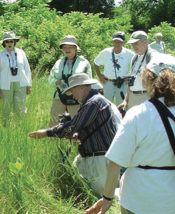Pet Pages
Annual butterfly count has a new record in the wings

Volunteers count butterflies
photo: Courtesy NABA.org
photo: Courtesy NABA.org
O’Brien led a record 34 participants on the 16th Annual San Francisco Butterfly Count on June 7, 2010 – almost double the old record of 18 volunteer spotters. Starting from the Randall Museum parking lot, the group was split into teams to roam the City counting as many butterflies as they could find.
The record number of counters, maybe not surprisingly, found a record number of butterflies – both in number of species and total number of insects. By the end of the day, 775 of the winged beauties had been spotted, totaling 24 species that included numerous varieties of swallowtails, painted ladies and skippers. You can see a full accounting at Nature in the City’s website (www.natureinthecity.org/butterflies.php).
In comparison, 22 species with around 500 individuals were sighted in 2009.
San Francisco’s yearly census is a volunteer effort done in association with the North American Butterfly Association, which helps facilitate counts throughout North America. These counts gather widespread data that helps monitor butterfly populations while raising public awareness and interest in butterflies.
Similar counts occur worldwide. “The Big Butterfly Count” was organized for the week of July 24 to Aug. 1 in the United Kingdom, where residents were urged to count butterflies for 15 minutes anywhere outdoors and log the information online. Set up for the novice, a chart of common butterfly species was provided; more experienced lepidopterists could add additional species as needed. You can see the results this month at www.bigbutterflycount.org.
Since butterflies react quickly to changes in their environment, the increase or decrease of populations can be the first harbinger for other wildlife populations. While counts may seem an inexact science, they do provide valuable information for biodiversity studies. As the U.K. count’s sponsors say, “... counting butterflies can be described as taking the pulse of nature.”
O’Brien encourages novice enthusiasts to join the local annual count. “We do a hardcore day of counting,” he said, “but unlike at bird counts, we chat our heads off out there.”


